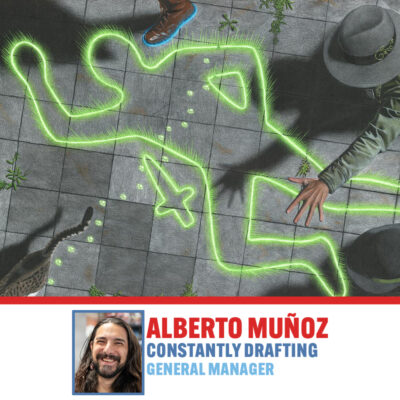Berto here, from Owl Central Games. If you don’t know me, I’m the General Manager of Owl, but more importantly, I’m a draft junkie. My favorite thing about Magic: the Gathering is diving into a new limited format, exploring all the different strategies it has to offer, and finding that sweet balance between winning games and having fun. I’ve been drafting Murders at Karlov Manor a ton, and I felt compelled to share my experience of the format. MKM draft has been an absolute blast, it’s super deep and complex, and I have found the replayability of the format to be greater than most of 2023’s releases.
While Wizards of the Coast has their well-defined two-color archetypes, I’d love to discuss a very practical approach to draft based on my experience with the format. I’ll identify each strategy’s potential and highlight some key cards. These are the practical archetypes that you should be thinking about while drafting Murders at Karlov Manor.
The Archetypes
White Based Aggro
White is widely considered to be the “best,” or at the very least, the deepest color at common rarity. This color is also home to what I consider to be the single best common in the set, Novice Inspector. White based decks want to end the game extremely quickly and they absolutely have the tools to do it at common and uncommon, so if white is open at your draft table, you can easily put together an aggro deck that your opponents will struggle to stabilize against. It’s the first thing to be looking for while drafting MKM.
The reason these White decks are so resilient is their ability to leverage a consistent go-wide strategy. Cards like Dog Walker and Inside Source provide you with cheap creatures to flood the board. Then you can get paid off by triggering two drops like Marketwatch Phantom and Seasoned Consultant to pressure your opponent in the early turns.
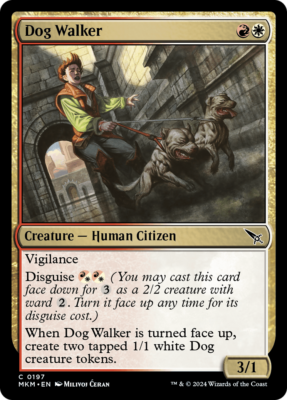
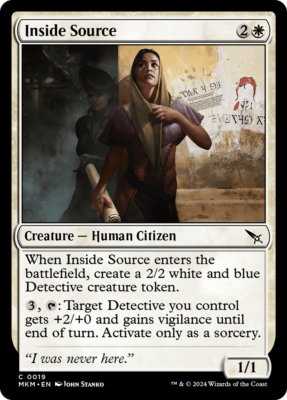
At uncommon, Case of the Gateway Express and Neighborhood Guardian also pay you off big time for playing multiple cheap creatures to the board. But ultimately, the reason these White decks can consistently end games is by leveraging combat tricks to keep opponents on the back foot. If your opponent isn’t on the aggro plan, they’re likely playing Disguise creatures as three-mana 2/2s on turn 3, which doesn’t bode well against a wide board and cards like Auspicious Arrival and On the Job. Not only can these cards finish off your opponent or get rid of pesky blockers, they also provide you clue tokens to help you dig for more action, which aggro decks historically struggle with.
White pairs well with literally any of the other colors, but Red is a great fit with aggressive creatures of its own and efficient interaction spells like Shock and Galvanize. Play White alongside Blue to lean on Detective synergies and tempo tools like Private Eye, Reasonable Doubt, and Out Cold. Use Green for bigger go wide pay offs like Greenbelt Radical, Crowd-Control Warden, and Fanatical Strength as your trample trick finisher. Black also provides efficient interaction, and 2 power matters synergies with cards like Long Goodbye, Extract a Confession, Wispdrinker Vampire, and Slimy Dualleech.
If White seems open at your draft table, narrow in on the best aggressive White cards. If you can identify a second color that is open to pair with White and you move in on that, your deck should come together nicely!
Green Based Midrange
While it can be extremely satisfying to run over your opponent with White decks, anyone familiar with the format knows how to draft and build a deck that can resist that kind of pressure. The tools very much exist in this format to overcome an opponent’s quick start. There are some more expensive, powerful, and just bigger cards available to stonewall your aggro opponents to take over the game, but knowing which cheap and efficient cards to prioritize, and how to find the balance between a low mana curve and a powerful top end, can be tricky business.
All those tools can be best leveraged by Green based decks in Murders at Karlov Manor. That tool kit is hyper flexible due to Green’s ability to fix mana and splash more powerful cards. The payoffs, the reasons to play Green, and what colors you play alongside it, are very dependent on the higher power and rarity cards you open in your draft. But let’s at least talk about the foundation of these decks.
Midrange is all about playing to the board, and seeking out more value out of your cards than your opponent does, and there are lots of ways to do that in Green. The most important cards to prioritize are Nervous Gardener, which only has a disguise cost of G, and Loxodon Eavesdropper. Both of these cards are two for ones, which again, is the name of the game in Midrange.
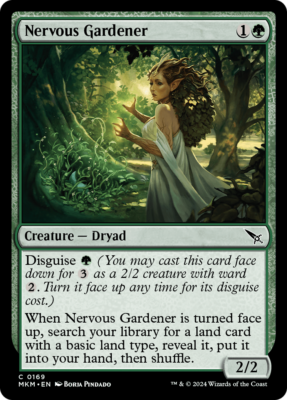
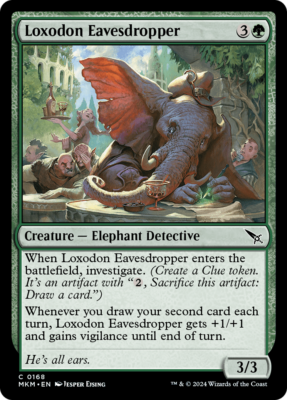
Essential to stabilizing are your other priority cheap creatures as well as efficient removal. Creatures like Aftermath Analyst and Vitu-Ghazi Inspector are solid turn 2 plays to stop 2/1s and blank 2/2s, but they both also provide you better value later in the game. Not to mention Analyst putting Collect Evidence fodder in your graveyard for Bite Down on Crime. Being able to pay two mana for a bite spell is necessary to stay alive. If Green is open and you are able to get these 2-4 drops as the foundation of your deck, then you won’t have a problem finding the second or even third color you need to fill in the rest.
I already touched on White as the most assertive version of Midrange alongside Green. Both Blue and Black provide some amazing pockets of synergy and late game inevitability if you lean into the Collect Evidence/Graveyard strategies. Forensic Researcher and Evidence Examiner give you repeatable ways to Collect Evidence. Pair these with Chalk Outline and you have an insanely powerful engine that it’s difficult to lose with. If you lean into the Chalk Outline plan, you can supplement with Rubblebelt Maverick, Gravestone Strider, Crimstopper Sprite, and Surveillance Monitor as other ways to trigger Outline and get value.
You do need to make sure you have ways to fill the graveyard. This is where Topiary Stomper, Projektor Inspector, Flotsam//Jetsam, Festerleech, and Snarling Gorehound help glue things together. One card I have been incredibly impressed with that you get to play in Blue/Green is Repulsive Mutation. I just couldn’t help mentioning this card’s flexibility as somewhere to put your mana, a way to protect your most powerful cards, or as a Fireball finisher to end the game out of nowhere.
As I mentioned before, the actual design of this Green based deck, and which colors you play with it, is highly dependent on the powerful cards you open. Splashing Red for bombs or efficient interaction is not uncommon if you’re playing Green/White. And I already showed how nicely Blue and Black can play together with Green. So just make sure that you’re enabling splashes for the most powerful cards by prioritizing Nervous Gardner and lands. The Rare duals are especially powerful with Gardner being able to fetch them up, but I have also been extremely happy with Escape Tunnel, Public Thoroughfare, and Scene of the Crime. A notable mention if you’re in Green White is Buried in the Garden as a catch all removal spell that ramps and fixes your mana.
The lighter the splash and the more streamlined your color pair with Green is, the more interested in Escape Tunnel I am. Especially if you’re hyper assertive, Escape Tunnel can be a win-condition in and of itself. But if you’re hurting for options to make your splash work, I’m happy to run Thoroughfare.
If you Pack 1 Pick 1 Izoni, Center of the Web or Doppelgang, then this is the deck you should definitely be drafting!
Blue Based Synergy
This bucket or strategy has some overlap with the previous two archetypes, but I think can be unique enough on its own to warrant discussion. My impression of Blue is that it is underrated and underdrafted at the moment because Blue decks are under a lot of pressure to be greater than the sum of its parts. If you don’t know how to maximize the synergies that different Blue cards unlock between different color pairs, then you’ll end up seeing more floors than ceilings, which will leave you with a bad impression.
That does mean that Blue isn’t for the faint of heart in MKM draft and why I think folks on the Arena ladder are playing it less than they could or should be. The spectrum of Blue based synergy decks varies from facially obvious to finicky and vulnerable. A common thread throughout all of these decks though will be Blue’s absolute hands down best common, Projektor Inspector. I’ll happily play three or four of these in any Blue deck.
Blue/White Detectives, while being one of the White aggro decks previously mentioned, is more synergy focused. The typal synergies can be very powerful with cards like Perimeter Enforcer and Private Eye. You also get other flying detective creatures like Crimestopper Sprite and Cold Case Cracker. 4 mana should be the top of your curve in this deck to leverage the tempo tools I mentioned earlier, like Unauthorized Exit and Out Cold, which I’ll mention again since I think it is an essential card to this strategy.
Blue/Red is the next step in the spectrum on the complexity scale. This synergy deck is still facially obvious. It’s all about making clues and drawing cards. You can play this deck in two ways. There’s the assertive tempo version that plays similarly to Blue/White. Then there is the more controlling late game version. Let’s hit the cards that both versions have in common, then note some differences.
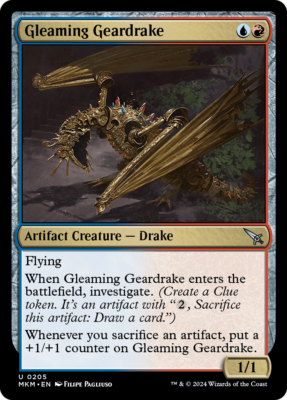
Gleaming Geardrake is a very powerful reason to play this color pair. You can combo this card with Harried Dronesmith to add a counter to Geardrake every turn. Case of the Filched Falcon is an efficient way to make a clue and get incredible value in the mid-game. Eliminate the Impossible is a massive blowout to your opponent, on attacks or blocks, and makes you a clue for your artifact strategy. And obviously, Red has the aforementioned efficient interaction in Shock and Galvanize, but this deck is the only good home for Suspicious Detonation to deal with some bigger threats.
If you’re looking to be aggressive, you’ll want to load up on Reckless Detective, Red Herring, and Person of Interest. And if you’re lucky enough to have Projektor Inspectors, then Jaded Analyst becomes an unassuming threat that you don’t mind trading off with on blocks.
There are some really good reasons to build this as a late game controlling deck but mainly, it’s to lean on Detective’s Satchel. You have good removal and solid counter spells and tempo tools to get you to the mid and late game and if you can set up Satchel and stabilize, it will be difficult for your opponent to overcome that engine. Because you get to play more instant speed interaction, this proves to be the best home for Deduce, giving you multiple ways to use your mana on your opponent’s turn while concealing counter spells, removal, and tricks, keeping your opponent guessing. If you see an Ill-Timed Explosion Pack 1 Pick 1, then this is the version of Blue/Red you want to try and get into!
We have essentially already discussed the synergies that Blue unlocks with Green decks, so the last thing to touch on is how Blue pairs with Black. This color combo has a hard time enacting a consistent or powerful strategy using only commons and uncommons. This is meant to be a hard control deck, with heaps of interaction on the stack and on the board, but with so many value creatures and ward creatures running around, it’s really hard to play a one-for-one control game efficiently and with success.
That’s not to say that you can’t have success with this color pair, but you realistically need to draft some serious bombs in these colors, and/or prioritize land based fixing so that you can splash powerful cards and interaction in White or Red. As far as the synergy component in Blue/Black goes, Persuasive Interrogators is a very real win condition alongside your Blue cards generating clues for you.
Notable cards for this strategy are the good Blue cards we’ve already mentioned alongside Toxin Analysis, Unscrupulous Agent, Long Goodbye, Extract a Confession, and Murder. Regarding Black removal, Murder is last for a reason and shouldn’t be overvalued in your draft considering how inefficient it is at keeping you alive in the early game against ward creatures. Again, all the power in this deck is going to be at high rarity.
Multi-Color Rares
Remember when we talked about the Green midrange decks that are good at splashing? Well, there are definitely tools to take that all the way to 5 color good stuff, and considering the power level of the uncommons and rares in Murders at Karlov Manor, there are some great incentives to draft it. There are two bits of context that I think are making it possible and relevant to get into a 4c or 5c deck in this format.
Firstly, there is a lot of power in single color cards, and the color pairs can be very high synergy and streamlined. Because of this, you can sit in a draft pod where, by pack two, most drafters are in their streamlined color pairs, and are passing around multi-color bombs that don’t fit into their two color mana base. This creates major opportunities in packs two and three to pick up those multi-color bombs.
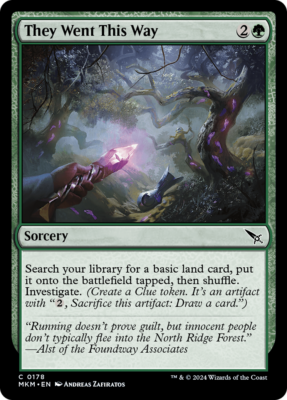
Secondly, there are so many great tools for mana fixing in this format. The best fixing options exist if you’re base green and snapping up Nervous Gardeners and They Went This Way. I’m not a huge fan of that three mana ramp spell, but if your top end is so overwhelmingly powerful, then you should be able to catch up quickly with your 5+ mana cards. Just don’t forget to draft a responsible curve that includes all the solid two drop green creatures I’ve previously mentioned.
Other tools in Green to consider if you’re going for 4+ colors are Flourishing Bloom-Kin and Aftermath Analyst. Bloom-Kin can fetch your rare surveil lands that touch Green, making it extra powerful in multi-color. And Aftermath Analyst can do the turn four block/sac ramp thing really well. Analyst gets better in this deck though because you’re highly incentivized to pick up Escape Tunnel and Scene of the Crime, both of which are color fixing lands that can put themselves in the graveyard and get recurred with Analyst.
You don’t have to be base green to play this deck though. If you highly prioritize the Rare surveil lands, and all the other fixing lands, leaning more heavily on Public Thoroughfare and Scene of the Crime as multi-color fixers, then you can develop a pretty functional 4+ color mana base. There is also Gravestone Strider and Case of the Shattered Pact that you can lean on. Strider and Pact are not ideal cards, but they are absolutely serviceable. Not to mention, if you speculate on a card like Pact early enough and can enable it, the effect it provides is absolutely game breaking.
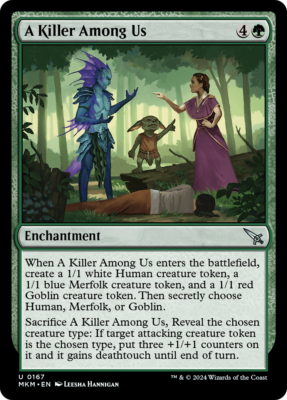
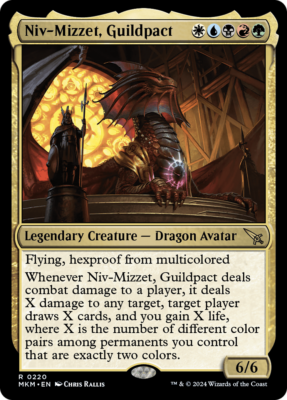
Cards that enable pact and are just excellent cards in this format are A Killer Among Us and Niv-Mizzet, Guildpact. A lesser enabler for 5 color is Leyline of the Guildpact but you should only consider including this card in your deck to specifically enable Case of the Shattered Pact. Otherwise, the cost of hard-casting it puts you way too far behind and getting it onto the battlefield for free on turn 0 feels more like a mulligan if you’re not using it to do something degenerate.
Just because this deck exists doesn’t mean it’s open in every draft. But knowing that it’s there, how to get into it, and what to prioritize, can create a power ceiling in the format that your opponent can’t possibly beat. As for the rest of the formula for this deck, it’s very important to establish one or two base colors and to prioritize one to three mana plays that affect the board and keep you alive to play a long-game.
Then, the rest of your deck can be all the most powerful cards you see in your draft, including all the best mono colored removal you can find, like Shock, Long Goodbye, Makeshift Binding, Galvanize, Torch the Witness, Bite Down on Crime, and all the wraths you can pick up. The fact that there are three solid board wipe effects with No Witnesses, Ill-Timed Explosion, and Deadly Cover-Up really enables this Multi-Color Rares strategy.
Conclusion
Murders at Karlov Manor is awesome to draft. I’m so eager to get back to Arena to experiment with what’s possible in this format. On my bucket list is Chalk Outline, Projektor Inspector, Curious Cadaver, loops, and popping off with Insidious Roots. And I’m convinced you can play an actual hard control deck in Esper colors if you get both the white and black wrath and some on color bombs.
I’ve had winning drafts with Green/Red beatdown and Red/Black suspect, but these color pairs just don’t really keep up with the broader strategies I’ve outlined here. You can absolutely win with those decks, especially if you’re leveraging powerful on color rares, but it’s not the direction I’m hoping to go in.
So go forth and draft! I’m hoping to get back into the store for an FNM draft of Murders at Karlov Manor soon and I can’t wait. Perhaps you’ll be drafting there with me!
